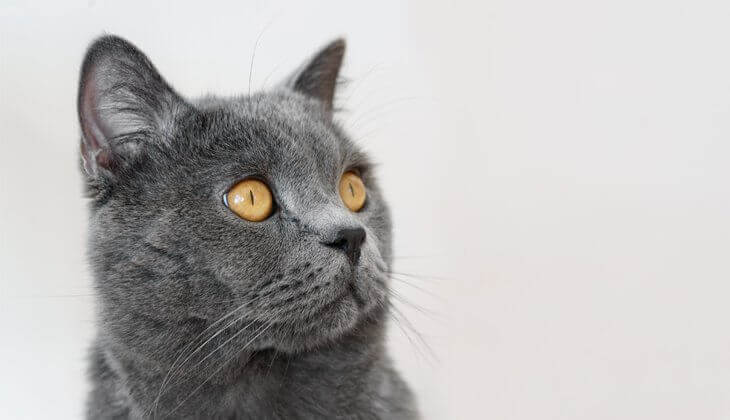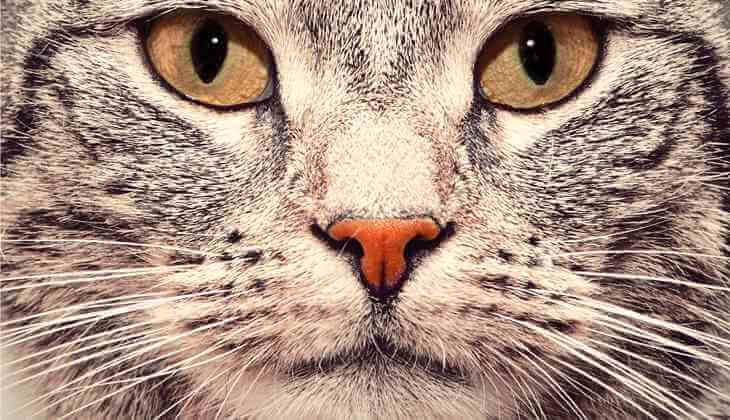Your furry feline friend is the descendent of a long lineage of predatory cats. Their role as household pet is relatively short compared to dogs, which were domesticated over 30,000 years ago, while cats were brought into people’s homes only a few thousand years ago. And while your modern house cat may not need to hunt out in the wild the same way his or her ancestors did, your pet still has a variety of acute cat senses, just like a highly efficient predator.
CAT HEARING
People often wonder, do cats have good hearing? In fact, you and your cat have the same range of hearing on lower levels, but when it comes to higher pitches, your cat can out-hear even dogs.
YOUR CAT’S EARS ARE LIKE SATELLITES, WITH THE ABILITY TO SWIVEL 180 DEGREES, THANKS TO THE MUSCLES IN THEIR OUTER EARS.
While humans only have 6 outer-ear muscles, your cat has 32 muscles, which allow the feline to rotate the earcups independently of each other. They can also estimate the position of an object (usually their prey), and distinguish between sounds.
Cats can also detect a higher frequency range than both humans and dogs. They can determine where a sound is coming from by sensing differences in the time of arrival to one or both ears, and the intensity of the sound received by the ears. They perceive extremely high and quiet sounds and the combination of all of these abilities allows cats to hear even the tiniest squeak of a mouse hiding under ground!
As a cat owner, you might want to consider your feline friend’s sensitive ears the next time the tea kettle whistles or the computer monitor is buzzing. Any day-to-day sound in the home is going to be much more intense for those pointy ears. Similar to humans, however, the hearing of a cat can also diminish with old age. It is not uncommon for senior cats to lose their hearing completely and become deaf. If you suspect hearing loss in your cat, it is best to consult your veterinary practitioner.

CAT VISION
t has long been held that cats have some sort of super vision and that they can see in the dark. But, how do cats really see? In fact, the visual acuity of cats is actually 10 times less than humans. Where their vision surpasses most mammals is in their ability to see well in low light. Cats have a reflective layer located in the back of their eyes, called the tepetum lucidum. This allows the eyes to adjust the amount of light that passes through the retina, increasing it when necessary, in particular, at dusk. This reflective layer is also responsible for the supernatural glow in their eyes when they are illuminated in the dark. However, cats cannot see any better than humans in total darkness.
The actual size and placement of a cat’s eyes on his or her head are actually ideal for accurately estimating distance of prey (for example). The structure of the cat’s retina is also a key component in locating prey, because it is composed of a number of receptors, or movement detectors.
DO CATS SEE COLOUR?
We often wonder what do cats see? And what colours do cats see? While it has long been assumed that cats cannot see colour, there is no definitive conclusion on the matter. Some research has suggested that cats can actually distinguish between colours but absolutely cannot identify the colour red. For the most part however, colour does not seem to really play a very important part in the everyday life of a cat.

A CAT’S SENSE OF SMELL
If you are wondering, do cats have a good sense of smell, your cat’s sense of smell is actually very well developed by the time he or she is an adult. While his or her sense of smell does pale in comparison to the super-powered sniffers on dogs, your cat still has a far superior sense of smell than you do.
Within your cat’s tiny little nose, he or she has 10 times the smell-sensing surface compared to your own.
They use this to evaluate food or fellow felines, not so much for hunting. When wandering around his or her own territory, your cat uses smell primarily to sniff out boundary markers and to identify other cats based on gender, hormones and social position.
Smell is especially crucial for cats when it comes to evaluating food. A cat whose nasal passages become clogged as a result of illness may appear to lose his or her appetite completely. If you see your cat turning up his or her nose at food, you may want to consult your veterinary practitioner.
Looking for a Veterinary Practitioner?
Your veterinary practitioner plays a big role in your pet’s health. Enter your location information and get a list of vets near you.
FIND A VETERINARY PRACTITIONER NEAR MEA CAT’S SENSE OF TASTE
People are often curious to know if cats can taste. And while it may look like your cat is happily devouring a nightly meal, several senses are actually hard at work, all at once. In addition to taste, your cat is also evaluating the food through smell, temperature, size and shape. Cat food manufacturers have long understood that cats prefer canned food in chunks, which resembles their prey in consistency and shape. Dry food is favoured if it is crunchy, like the bones of rodents. Also, any food that is slightly warmed, like freshly caught food in the wild, will also make your feline friend happy.
If you’re wondering if your cat have taste buds, the fact is that your cat does have taste buds, which are similar to yours in some ways, but also quite different. Your taste buds can distinguish sweet, sour, bitter, salty and savory, however, your cat cannot taste sweet. Some researchers believe that since cats are genetic carnivores and are driven to consume meat, they have no reason to have a taste for sugar. If you have a cat that seems drawn to sweets, it is more likely that the fat content in the food is what is enticing to him or her. Cats are extremely good at detecting fat! Likewise, the bitter and sour taste sensors in your cat’s tongue are extremely important, as they warn him or her of poisonous food or objects.
A CAT’S SENSE OF TOUCH
From birth, touch is a primary source of affection for cats and it is a fundamental sense in kitten development.
Cats groom themselves and each other, they lay against one another, and grown cats often behave like kittens when they are stroked by their human companions, in the form of kneading.
Your cat is extremely sensitive to touch because each hair on his or her body has nerve endings, and every time you pet your feline friend, you evoke a response from the nervous system.
The hairs on the body also act as receptors to the world around your cat. The same is true of your cat’s whiskers, which were designed to detect even the smallest change in the environment. Because of these highly sensitive attributes on your cat, people have long believed that cats can detect earthquakes, diseases, even impending death!

KITTEN DEVELOPMENT OF SENSES
Kittens go through a few stages of development. At birth, kittens are blind and deaf. Their ears and eyes open between 5 and 15 days and once they do, they can begin to send and receive information from other cats, animals and objects in their environment.
At approximately 2 weeks, kittens start to show orientation to sounds and at about 3 weeks they start to follow visual stimuli. By 4 weeks of age, kittens are moving and interacting with their environment, but their signals are indistinct, they have not quite mastered all of their senses. Over the course of the next couple of weeks however, they will learn to use their keen senses the way generations of cats before them have.






 Go To United States
Go To United States Austria
Austria Belgium
Belgium Czech Republic
Czech Republic Denmark
Denmark Europe
Europe Finland
Finland France
France Germany
Germany Greece
Greece Hungary
Hungary Ireland
Ireland Israel
Israel Italy
Italy Netherlands
Netherlands Norway
Norway Poland
Poland Portugal
Portugal Romania
Romania Saudi Arabia
Saudi Arabia Slovakia
Slovakia Spain
Spain Sweden
Sweden Switzerland
Switzerland Turkey
Turkey United Kingdom
United Kingdom